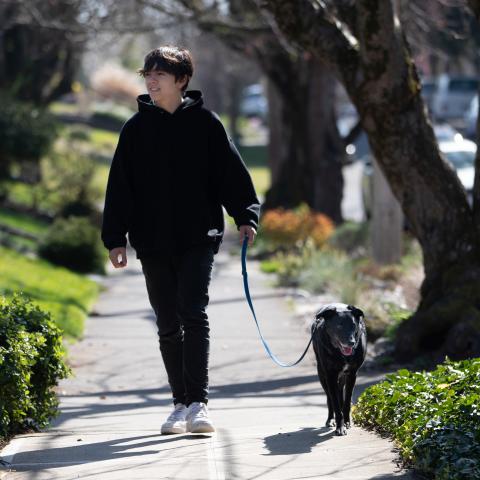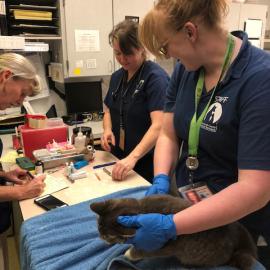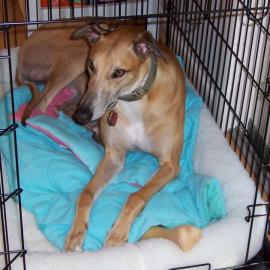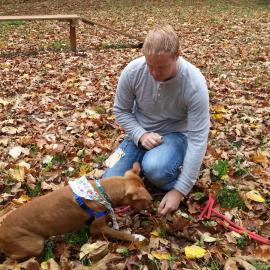Managing Separation Anxiety In Pets
Learn new ways to help manage your pet's separation anxiety, fear, or stress while you're away.
You return home from work. You turn your key and open the door, anxious to greet your canine companion whom you’ve missed all day. The scene before you is breathtaking. What was once the laundry-room door is now a trail of wood chips. Your living room is a blizzard of furniture stuffing. The garbage can and its contents have exploded around the kitchen. Your dog is beside themselves with anxiety, but happy you’re home!
Separation anxiety is one of the most common behavioral issues reported by pet owners. It’s a condition where your pet experiences distress when separated from the people they’re bonded with. If you have a pet with separation anxiety, you probably already know it, worry about it, or have experienced at least some degree of destructive behavior, barking, or house-soiling.
An anxious dog may chew through their crate, the laundry-room door, and jump through a window. An anxious cat may become irritable or fearful with other animals, hide, or go to the bathroom in your clean laundry basket.
While the nightmares described above are a worst-case scenario, it’s also a natural fearful or frustrated reaction to an abrupt disruption of routine, or fear of being left behind. Your pets are extremely social animals who want to be around you. There are ways you can prepare your pets, ease into a new routine, and manage their separation anxiety.
Even if you don’t believe your pet experiences separation anxiety, the following practices and tips will help your pet if you’re returning to the office regularly after a period of teleworking, or if they’re coping with more alone time than before.
Exercise
- Take a morning walk - provide your dog with 20 to 30 minutes of exercise before leaving the house.
- Play with your cat with a string or a laser pointer before leaving the house.
Treats
- Provide them with a long lasting, special, and safe treat for your departure.
- Frozen Kongs with peanut butter and high-value treats
- Food puzzles
- Wet food
- NOTE: Avoid treat options that they could potentially choke on while you’re away. For dogs, this includes bones, rawhide chews, or other treats that need supervision.
Leave and return calmly
- Ignore your pet’s over excitement upon your return and interact with them once they are calm.
- Reward the calm behaviors you want to see.
Minimize your routine
- Practice with your pets when you are not leaving
- Grab your keys and then make dinner
- Go out to the car then come back inside.
Consider a pet sitter or boarding facility
- Leave your pet with a family member or friend for the day.
- Have a friend or neighbor check on your pets while you’re away, and provide a bathroom break.
- Social dogs may benefit from an open boarding facility - like the dog park every day.
- Crating is discouraged for extended periods of time.
- Crate training is a process, and it has its benefits to create a safe, calm space for your dog.
- Crating is not humane or practical for extended periods of time.
- Puppies shouldn’t spend more than 5 hours in a crate.
- Adult dogs no more than 8 hours per day, and not regularly.
Behaviorist Support
If your pet has separation anxiety, it’s in your pet’s best interest and your best interest to address and manage their issues. Help them develop skills and default behaviors that are going to serve them and their people, and keep them happy and safe.
- Consult with a Pet Behaviorist or trainer to pinpoint triggers
- Develop a plan to modify behavior through positive reinforcement.
It’s helpful to realize that there’s no right/wrong or naughty behavior with pets. That’s not the way they think. Pets don’t need to be punished, shamed, or made to be afraid or dominated. A qualified trainer or behaviorist will find a way to humanely generate the behaviors you want to see, then reward them.
Learn more about local and online Training & Behavior Resources
Veterinary Support
- Consult with your veterinarian about treatment options for fear, anxiety, or stress-related behaviors.
- Your vet may be able to refer you to specialists.
- Prescribed medication may be an option to manage separation anxiety, at least for a period of time.
Learn about local low cost veterinary resources
Focus on the Outcomes
You want your pet to be happy. Just as every animal should have freedom from hunger, thirst, discomfort, pain, injury, and disease, they should also have freedom from fear and distress. The mental health of an animal is just as important as their physical health.
You want your relationship with your companion animal to be positive and long-lasting. They’re better off with you, their family, than being anywhere else. No lasting relationship is without bumps in the road or problems to work through and manage. They’re worth it. Your relationship is worth it.

Motoya Nakamura


